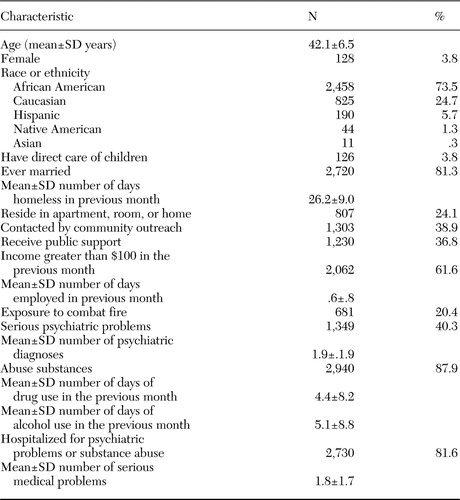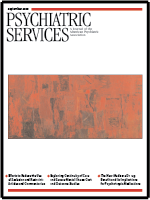Brief Reports: Predictors of Children's Involvement in Parents' Treatment Among Homeless Veterans in Community Residential Care
Abstract
This study identified the proportion of homeless veterans who are parents and described characteristics of homeless veterans whose children became involved in their treatment. Of the 9,444 veterans surveyed, 37.7 percent were parents of children younger than 18 years; yet children were involved in parents' treatment in only 10.6 percent of these cases. Parents whose children were involved in their treatment were more likely to have direct custody, be female, have greater social stability, and have more psychiatric and medical problems. These parents were also less likely to have been exposed to combat fire. Services to homeless parents might be improved through coordination of adult- and child-focused funding streams and programmatic efforts to provide comprehensive interventions.
Women and their children account for at least one-third of the homeless population, represent its fastest growing segment, and require more intensive psychiatric, medical, and social services than individual adult homeless persons (1,2,3,4). Women may become separated from their children because of lack of available child care in residential facilities or because of the perception that homeless status represents neglect (5,6). Homelessness among veterans has also received substantial attention almost entirely from the perspective of individual, adult-oriented services (7,8), with scant attention to the situation of homeless veterans who are parents and may have children in their care. The study reported here represents an attempt to identify the proportion of homeless veterans who are parents and to describe characteristics of homeless veterans whose children became involved in their treatment.
Methods
Data were extracted from administrative records of veterans admitted between 1996 and 2001 to the homeless providers grant and per diem program of the United States Department of Veterans Affairs (VA), an initiative providing residential and support services to homeless veterans through grant awards and per diem payments to community nonprofit and local government agencies (9). Unlike traditional VA-based services, this program potentially allows veterans and their children access to services that are funded by multiple sources—for example adult psychiatric services funded through the VA and child psychiatric services funded through non-VA sources.
Demographic variables included age, gender, and race or ethnicity of the veterans. Social and community functioning variables included the presence of children in the veteran's direct care; marital status; days homeless in the previous month; residence in an apartment, room, or house before intake; initial contact through community outreach; receipt of public support, monthly income greater than $100 in the previous month; days employed in the previous month; and exposure to combat fire.
Clinical variables included presence and number of serious psychiatric problems, presence of substance abuse, days of drug use and alcohol use in the previous month, history of hospitalization for psychiatric or substance abuse problems, and number of serious medical problems.
To determine characteristics of parents whose children were involved in their residential treatment relative to parents whose children were not involved, the dependent variable was coded as the absence or presence of their children's involvement in treatment (0 or 1). Individual chi square tests and one-way analyses of variance were used to assess differences in proportion and means. Characteristics that were significantly different were entered in a multivariate logistic regression analysis by using a forward stepwise procedure with demographic variables entered in the first block and social, community, and clinical variables in the second.
Results
The sample consisted of homeless veterans who received residential services funded through the VA homeless providers grant and per diem program. To ensure a sample of veterans who might have children involved in their care, the sample was restricted to veterans 60 years or younger who participated in programs that reported children's involvement in at least one veteran's care. Of these 9,444 homeless veterans, a substantial proportion (3,565 veterans, or 37.7 percent) were parents of children younger than 18 years; yet children were involved in their parents' treatment in only a small fraction of these cases (378 veterans, or 10.6 percent). The sample for the regression analysis was restricted further to veterans who were parents and consisted of 3,346 participants for whom data were not missing. Table 1 shows characteristics of the sample.
Table 2 shows that the model to determine predictors of parents whose children were involved in their treatment accounted for 15.9 percent of the sample variance (Nagelkerke r2=.159) and correctly classified 89.9 percent of the sample. Parents whose children were involved in their treatment were much more likely to have their children under their direct care (odds ratio [OR]=11.83). Beyond their direct caregiving role, these parents were more likely to be female (OR=2.60) and to have greater social and community stability, as reflected by residence in a room, apartment, or house before intake (OR=2.05) and monthly income in excess of $100 (OR=1.34). In contrast, they had more serious medical problems (OR=1.22) and psychiatric diagnoses (OR=1.16) and were less likely to have a history of exposure to combat fire (OR=.64).
Several factors were not significant, so they were not entered in the multivariate logistic regression analysis: age, race or ethnicity, marital status, days homeless in the previous month, initial contact through community outreach, receipt of public support, days employed in the previous month, presence of substance abuse, days of drug use and alcohol use in the previous month, and history of hospitalization for psychiatric or substance abuse problems.
Discussion and conclusions
Thirty-eight percent of veterans served by this program had children younger than 18 years; yet only 11 percent of these parents had children who were involved in their treatment, despite the capacity of their treatment programs to concurrently serve their children. As one might expect, parents of children who were involved in their treatment were considerably more likely to be female and to have their children under their direct, personal care. Consistent with having their children in their care, parents whose children were involved in their treatment had greater social stability. However, they also had more serious psychiatric and medical problems than parents whose children were not involved in their treatment.
One might speculate that social stability is associated with successful treatment engagement and parents' symptoms with greater recognition of the importance of engaging children in the residential care of their parents. Because of the substantial proportion of homeless veterans who are parents of children younger than 18 years, the paucity of their children's involvement in their residential treatment, and the risk presented by homelessness to children's development and adaptation, this study highlights a crucial service need and a potentially missed opportunity for service delivery to homeless parents and children within and beyond the VA. Service delivery to homeless adults, particularly parents, might be improved when blended funding streams and programmatic efforts are integrated and used to provide comprehensive, coordinated interventions.
Although our study examined a large sample, it included only homeless veterans served by the VA grant and per diem program and may not represent the general population of homeless veterans. The data address neither the nature of children's involvement in veterans' care nor the types of child services available at the program facilities. Nevertheless, we felt that it was important to highlight the presence of children in the lives of homeless veterans as well as their infrequent involvement in their parents' treatment. Finally, the data do not allow conclusions about why so many veteran parents did not have their children involved in their care. Perhaps, consistent with literature indicating high rates of parent-child separation in homeless families (2,5), some veteran parents did not have access to their children because their children were placed with other relatives or with child protective services.
Future studies should explicitly address custodial aspects of parent-child relationships that mitigate or potentiate the use of child-focused services. In addition to examining the circumstances under which adult and child services can be coordinated or integrated, studies should examine the effectiveness of these services for homeless parents and their children, as coordination alone will not guarantee beneficial results.
Dr. Murphy is affiliated with the Center for Child and Family Health and the department of psychiatry and behavioral sciences at Duke University, 3518 Westgate Drive, Suite 100, Durham, North Carolina 27707 (e-mail, [email protected]). Dr. Kasprow is with the department of psychiatry and Dr. Rosenheck is with both the department of psychiatry and the Child Study Center at the Yale School of Medicine in New Haven, Connecticut.
 |
Table 1. Characteristics of 3,346 homeless veterans in residential care who had children younger than 18 years
 |
Table 2. Predictors of childrens involvement in their parents treatment among homeless veterans in residential care who had children younger than 18 years (N=3,346)
1. Duchon LM, Weitzman BC, Shinn M: The relationship of residential instability to medical care utilization among poor mothers in New York City. Medical Care 37:1282–1293,1999Crossref, Medline, Google Scholar
2. Hicks-Coolick A, Burnside-Eaton P, Peters A: Homeless children: needs and services. Child and Youth Care Forum 32:197–210,2003Crossref, Google Scholar
3. Weinreb L, Goldberg R, Perloff JN: Health characteristics and medical service use patterns of sheltered homeless and low-income housed mothers. Journal of General Internal Medicine 13:389–397,1998Crossref, Medline, Google Scholar
4. McQuiston HL, Finnerty M, Hirschowitz J, et al: Challenges for psychiatry in serving homeless people with psychiatric disorders. Psychiatric Services 54:669–676,2003Link, Google Scholar
5. America's Homeless Children: New Outcasts. Newton, Mass, Better Homes Fund, 1999Google Scholar
6. Hoffman D, Rosenheck RA: Homeless mothers with severe mental illness and their children: predictors of family reunification. Psychiatric Rehabilitation Journal 25:163–169,2001Crossref, Medline, Google Scholar
7. Rosenheck RA, Kasprow WJ, Frisman L, et al: Cost-effectiveness of supported housing for homeless persons with mental illness. Archives of General Psychiatry 60:940–951,2003Crossref, Medline, Google Scholar
8. Tessler R, Rosenheck RA, Gamache G: Comparison of homeless veterans with other homeless men in a large clinical outreach program. Psychiatric Quarterly 73:109–119,2002Crossref, Medline, Google Scholar
9. Kasprow WJ, Rosenheck RA, DiLella D, et al: Health care for homeless veterans programs: seventeenth annual report. West Haven, Conn, Department of Veterans Affairs Northeast Program Evaluation Center, 2004Google Scholar



